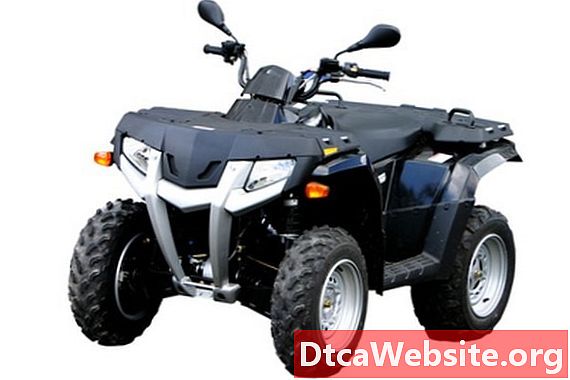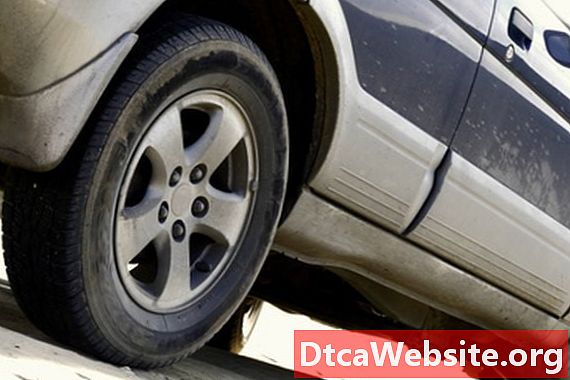
Contenu
- Outer Tie Rod End
- Step 1
- Step 2
- Step 3
- Step 4
- Step 5
- Inner Tie Rod
- Step 1
- Step 2
- Step 3
- Step 4
- Tip
- Items you will need
The Ford Escape features a rack-and-pinion power steering system. The inner tie rods connect directly to the power steering rack and the outer tie rods bridge the connection from the inner tie rods to the steering knuckles. When failure occurs between either the inner or outer tie rod, movement known as front end play is the result. The slightest play in the tie rod end connections can lead to more serious problems. Tire wear, vibrations and steering response are a few examples. If not repaired, the play will become more prominent and worsen the symptoms.
Outer Tie Rod End
Step 1
Turn the lug nuts 1/8 of a turn counterclockwise to crack loose before lifting the Escape. Lift the front wheel or wheels using a floor jack and support the Escape onto a jack stand or stands. Finish removing the lug nuts and then remove the wheels.
Step 2
Remove the cotter pin from the outer tie rod end stud using a pair of cutting dikes and discard. The replacement tie rod will feature a new cotter pin. Remove the castle nut using a ratchet and socket or a hand wrench set. Use an outer tie rod end removal tool to separate the outer tie rod end from the steering knuckle. Other methods could employ a pickle fork or leaving the castle nut on the end of the tie rod end stud and smacking it sharply with a hammer. Since youre replacing the outer tie rod end, it wont matter if you damage the dust boot or tie rod end.
Step 3
Break the jamb nut loose on the outer tie rod to the inner tie rod connection using a hand wrench. If stubborn, penetrating oil and/or a propane torch will work the jam nut loose. Allow to cool down before proceeding once the jamb nut is broken free, if applicable.
Step 4
Unscrew the outer tie rod end in a counterclockwise motion from the inner tie rod counting how many complete turns to remove it and then recording the count. This will help you install the new one and keep the toe adjustment as close as possible. Keep in mind some aftermarket outer tie rod ends may not have the exact same length as original equipment. A comparative measurement of both the old and new tie rod ends should be taken with a measuring tape and measurement adjustments may need to be made.
Step 5
Remove and replace the outer tie rod by reversing the procedure. Be sure to install the dust boot onto the replacement tie rod end before installing the stud into the knuckle. Tighten the castle nut to draw the tie rod end stud through the steering knuckle to 37-foot pounds using a torque wrench and socket. Align the openings of the castle nut to accommodate the replacement of the cotter pin through the hole in the stud.
Place the zerk fitting onto the outer tie rod end top and be careful to not over-tighten with a small hand wrench. Stop tightening when the threads of the fitting is flush to the top of the tie rod end. Use a grease gun placed onto the zerk fitting to fill and lubricate the ball joint of the outer tie rod end. When the boot expands fully, theres enough grease inside. Tighten the jamb nut to approximately 33-foot pounds.
Inner Tie Rod
Step 1
Remove the outer tie rod end as illustrated in Section 1.
Step 2
Remove the bellows boot clamps using a pair of cutting dikes. If damage occurs to the clamps, appropriate-sized radiator clamps can be employed as replacements for reinstall of the bellow boot. Remove the bellows boot.
Step 3
Use a pair of vise clamp pliers to secure the piston shaft of the inner tie rod end exposed by the removal of the bellows boot.
Step 4
Use the inner tie rod end tool with the correct-sized socket end to remove the inner tie rod end from the steering rack while securing the piston shaft. Remove the inner tie rod end from the steering rack and replace with new one by reversing the procedure. Replace the bellows boot and secure with clamps on both ends.
Tighten the new inner tie rod to the steering rack to 81-foot pounds using the inner tie rod end tool and the torque wrench with a suitable socket. Replace the outer tie rod end to the inner tie rod by following the procedure illustrated in Section 1.
Tip
- When replacing the wheels and lug nuts, tighten the lug nuts to 100-foot pounds using the torque wrench and a suitable socket. No matter how close the measurement of the tie rod replacement was to the original, an alignment is strongly advised to check the toe angle of the front tires. Toe adjustments made to the Ford Escape are manipulated by turning the inner tie rod and are measured in mere degrees, so it does not take much to knock out the toe specifications.
Items you will need
- Floor jack
- Jack stand(s)
- Tire lug wrench
- Ratchet and socket set
- Outer tie rod end separator
- Cutting dikes
- Hand wrench set
- Inner tie rod end removal tool with Ford socket adapter
- Vise clamp pliers
- Grease gun
- Torque wrench
- Replacement outer tie rod end
- Replacement inner tie rod
- Measuring tape


